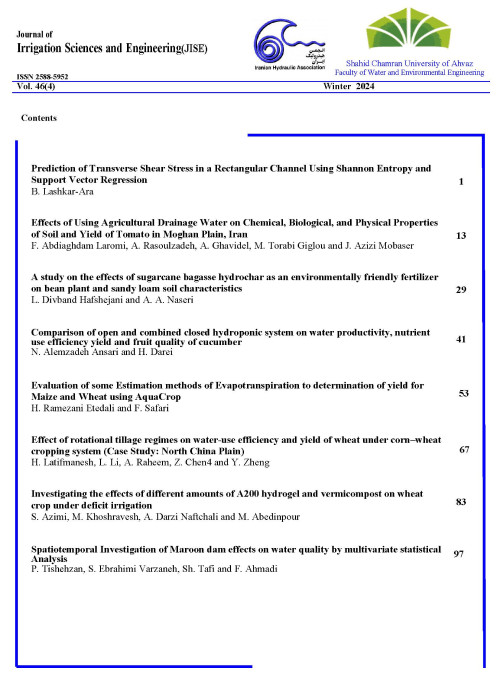Investigating the effects of different amounts of A200 hydrogel and vermicompost on wheat crop under deficit irrigation
The intensification of drought and water stress caused by climate change is a major factor in yield and productivity reduction in the agricultural sector in arid and semi-arid environments. Agricultural lands are often sorely affected by water tension caused by scarce and low precipitation. This research evaluated the effect of different amounts of water, vermicompost and hydrogel used to save the soil water content on wheat grain and biomass yield. Hence, an experiment was conducted at the research farm of Kashmar higher education institute to evaluate the effects of different amounts of hydrogel and vermicompost on wheat biomass and grain yield. Experimental treatments were included: four levels of A200</sub> hydrogel (i.e. 0(S0</sub>), 0.1(S1</sub>), 0.2 (S2</sub>) and 0.3 (S3</sub>) wt. %) plus four levels of vermicompost (0(V0</sub>), 7(V1</sub>), 10(V2</sub>) and 15(V3</sub>) tons per hectare) and three levels of irrigation water (60(W1</sub>), 80(W2</sub>) and 100(W3</sub>) percent of wheat water requirement). The experiment was carried out in a randomized completely block design (RCBD) in a factorial arrangement as a pot experiment in 144 pots. The results showed that the highest amount of biomass and grain yield was obtained in S3</sub>V3</sub>W3</sub> treatment amounting of 81.7 and 35 grams per pot, respectively. Also, the lowest biomass and grain yield was achieved in S0</sub>V0</sub>W1</sub> treatment at the rate of 35 and 10.2 gram per pot, respectively. Furthermore, grain and biomass yield were significantly affected (P ≤ 0.05) by different amounts of hydrogel and vermicompost under varying irrigation water levels. However, application of hydrogel and vermicompost compounds was not significant on the wheat yields. Overall, the best economic value for achieving the highest amount of grain yield was observed in (S2</sub>, 0.2%) of A200</sub> hydrogel and (V2</sub>, 10 ton/ha) of Vermicompost. Similarly, the highest amount of biomass was obtained in the (S3</sub>, 0.3%) treatment of A200</sub> hydrogels and 15 ton/ha (V3</sub>) of vermicompost. Based on the results, the application of moisture absorbents can be effective in increasing wheat yield in water deficit conditions in the arid and semi-arid environment.
Agricultural , Cereals , Kashmar , Pot , Water Stress
- حق عضویت دریافتی صرف حمایت از نشریات عضو و نگهداری، تکمیل و توسعه مگیران میشود.
- پرداخت حق اشتراک و دانلود مقالات اجازه بازنشر آن در سایر رسانههای چاپی و دیجیتال را به کاربر نمیدهد.


